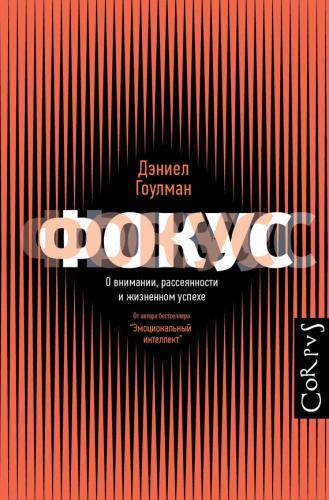36
Beilock S. et al. “When paying attention becomes counterproductive” // Journal of experimental psychology 18. 2002. V. 1. P. 6–16.
37
Вероятнее всего, попытки расслабиться ни к чему не приведут, особенно в тот момент, когда мы стараемся показать лучший результат. См. Wegner D. “Ironic effects of trying to relax under stress” // Behaviour research and therapy 35. 1997. V. 1. P. 11–21.
38
Wegner D. “How to think, say, or do precisely the worst thing for any occasion” // Science. 03.07.2009. P. 48–50.
39
Christian Merz et al. “Stress Impairs Retrieval of Socially Relevant In- formation” // Behavioral Neuroscience 124, no. 2 (2010): 288–93.
40
“Unshrinkable” // Harper’s magazine. 12.2009. P. 26–27.
41
Hakamara Y. et al. “Attention bias modification treatment” // Biological psychiatry 68. 2010. V. 11. P. 982–90.
42
Когда психологи провели с людьми, страдающими социальной тревожностью, несколько сессий, направленных на поиск в толпе не враждебно, а нейтрально и благожелательно настроенных лиц, у двух третей испытуемых ушло чувство дискомфорта. Schmidt N. B. et al. “Attention training for generalized social anxiety disorder” // Journal of abnormal psychology 118. 2009. V. 1. P. 5–14.
43
Chua R. Y. J., Xi Zou (Canny) “The devil wears Prada? Effects of exposure to luxury goods on cognition and decision making” // Harvard business school organizational behavior unit working paper. 2.11.2009. V. 10–034. Режим доступа: http://ssrn.com/abstract=1498525 или http://dx.doi.org/102139/ssrn.1498525.
44
Fitzsimmons G. J. et al. “Non-conscious influence on consumer choice” // Marketing letters 13. 2002. V. 3. P. 269–79.
45
Vuilleumier P., Huang Y.-M. “Emotional attention: uncovering the mechanisms of affective biases in perception” // Current directions in psychological science 18. 2009. V. 3. P. 148–52.
46
Ohman A. et al. “Emotion drives attention: detecting the snake in the g rass” // Journal of experimental psychology: General 130. 2001. V. 3. P. 466–78.
47
Blagrove E., Watson D. “Visual marking and facial affect: can an emotional face be ignored?” // Emotion 10. 2010. V. 2. P. 147–68.
48
Schackman A. J. et al. “Reduced capacity to sustain positive emotion in major depression reflects diminished maintenance of fronto-striatal brain activation” // Proceedings of the national academy of sciences 106. 2009. P. 22445–50.
49
Langer E. “Mindfulness”. Reading, MA: Addison-Wesley, 1989.
50
Klinger E. “Daydreaming and fantasizing: thought flow and motivation” in Markman K. D. et al., eds. “Handbook of imagination and mental stimulation”. New York: Psychology press, 2009. P. 225–40.
51
Cristoff K. “Undirected thought: neural determinants and correlates” // Brain research 1428. 1.2012. P. 51–59.
52
Там же, p. 57.
53
Christoff K. et al. “Experience sampling during fMRI reveals default network and executive system contributions to mind wandering” // Proceeding of the national academy of sciences 106. 26.05.2009. V. 21. P. 8719–24. Ключевыми исполнительными структурами являются передняя цингулярная кора и дорсолатеральная префронтальная кора. Частями сети состояния покоя являются медиальная префронтальная кора и сопряженные сети.
54
Wiley J., Jarosz A. F. “Working memory capacity, attentional focus, and problem solving” // Current directions in psychological science 21. 8.2012. P. 258–62.
55
Schooler J. et al. “Meta-awareness, perceptual decoupling, and the wandering mind” // Trends in cognitive science 15. 7.2011. V. 7. P. 319–26.
56
Цит. по: Johnson S. “Where good ideas come from”. New York: Riverhead, 2010.
57
White H., Singh P. “Creative style and achievement in adults with ADHD” // Personality and individual differences 50. 2011. V. 5. P. 673–77.
58
Weir K. “Pay attention to me” // Monitor on psychology. 3.2012. Pp. 70–72.
59
Carson Sh. et al. “Decreased latent inhibition is associated with increased creative achievement in high-functioning individuals”// Journal of personality and social psychology 85. 9.2003. V. 3. P. 499–506.
60
Liu S. et al. “Neural correlates of lyrical improvisation: an fMRI study of freestyle rap” // Scientific reports 2. 11.2012. V. 834.
61
Это высказывание Эйнштейна было процитировано Робертом Л. Олдершоу в комментарии, опубликованном в журнале Nature 21 мая 2012 г.
62
Lutz
